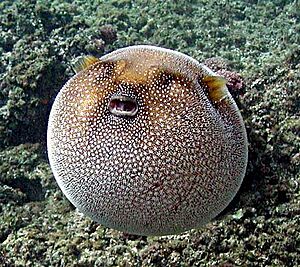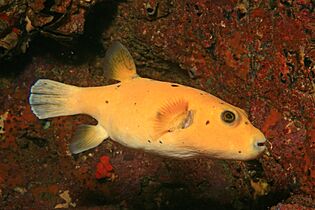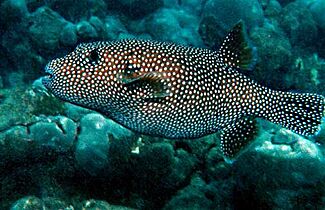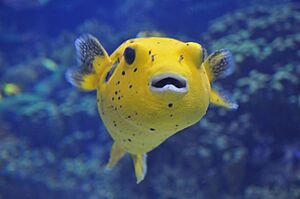Guineafowl puffer facts for kids
Quick facts for kids Guineafowl puffer |
|
|---|---|
 |
|
 |
|
| A photograph of A. meleagris in its dark form | |
| Conservation status | |
| Scientific classification |
The Arothron meleagris, also known as the guineafowl puffer or golden puffer, is a type of pufferfish. You can find it in the Indo-Pacific and Eastern Pacific waters. These fish can grow up to 50 cm long. Sometimes, they are caught for the aquarium trade.
Guineafowl puffers have round, heavy bodies. They can be all black with many small white spots, or bright yellow with yellow spots. Some even have a mix of both! They have big, blunt heads with short snouts and strong teeth. Their fins are small and shaped similarly, located far back on their body. Their tail fin is rounded. Their skin feels like rough sandpaper because it's covered in tiny bumps called denticles. When this fish gets scared, it can puff up like a ball. This makes it look much bigger, and its spiky skin stands out!
Contents
What Does the Guineafowl Puffer Look Like?
Guineafowl puffers come in a few different colors. The most common color is dark brown with many white spots all over its body. The spots near its tail are usually smaller than those on its sides. Most of these fish have light-colored fins that are dark brown with white spots, just like their bodies.
Another common color is bright yellow with black spots. Their fins are often yellow too, with the tips being whitish. The areas near their gills might be light brown.
There's also a mixed color type. Part of the fish's back might be brown with white spots, while its sides, belly, and head are yellow with black spots. Some parts around their mouth and gills can be light brown. Their fins can also be yellow with light brown rays. Sometimes, the whole head and body are bright yellow, but the fins are brown with white spots.
Studies show that the dark brown with white spots pattern is the most common. The yellow with black spots pattern is the rarest.
Rarely, a guineafowl puffer might have a very unusual color. One was found with white lines on a black-purple background instead of spots. It also had a black circle around its eye and a white pattern on its belly.
Since A. meleagris is a pufferfish, it has tough skin covered in tiny spikes. Its jaw bones are fused together to form a strong, beak-like mouth with four visible "teeth." This is how they get their family name, Tetraodontidae, which means "four teeth."
How Does the Guineafowl Puffer Defend Itself?
Guineafowl puffers are slow swimmers. Because of this, they use other ways to protect themselves. They have tough, spiky skin, and they can inflate their bodies with water or gas. They also carry a powerful toxin called tetrodotoxin.
When scared, they quickly gulp water into a stretchy stomach. This makes their elastic skin stretch out, and their small spikes stand up. They become a spiny ball, up to 3-4 times their normal size! This makes it very hard for predators to eat them.
They also use the tetrodotoxin as a defense. This is a very dangerous neurotoxin that can stop nerve and muscle cells from working. It builds up in the fish's liver and ovaries. The pufferfish itself is not harmed by this toxin. The toxin is actually made by tiny bacteria that the pufferfish eats. This chemical defense helps keep predators away.
Where Do Guineafowl Puffers Live?
You can find many Arothron meleagris on coral reefs in the Indian Ocean and eastern Pacific Ocean. They are less common on rocky reefs in the eastern Pacific. While their numbers grew in Costa Rica for a while, their population might be shrinking now. This is because their homes are being destroyed.
The trade of marine fish for aquariums might also be affecting their numbers. Guineafowl puffers are quite expensive in the aquarium trade, especially the yellow ones, which can sell for hundreds of dollars.
The destruction of coral reefs is a big problem for these fish. Coral reefs are their home and their main source of food. Many coral reefs around the world are being damaged or lost. When corals are gone, the guineafowl puffer loses its home and food, which can cause its population to decline.
These fish live in many places, including Indonesia, the Philippines, Hawaii, the Galápagos Islands, and along the coasts of Mexico and Ecuador. They are often found around seafaring islands, living at depths of 3 to 24 meters.
Even with these challenges, the guineafowl puffer is still a common species. The IUCN Red List of Threatened Species lists it as a species of "Least Concern." This means its population is currently stable.
How Do Guineafowl Puffers Live?
The Arothron meleagris is a very solitary fish, meaning it likes to be alone. It's similar to another pufferfish, Arothron hispidus, which also rests at night and swims among corals during the day.
Guineafowl puffers move through the water by wiggling their dorsal and anal fins together. When they swim forward steadily, their body is angled slightly upwards. As they swim faster, their body shape can change a bit, especially at the front. At high speeds, they might even open their mouths wide, showing their sharp teeth!
Their diet mainly includes corals and small invertebrates like tunicates, sponges, and sea urchins. What they eat can depend on how much coral is available in different reefs. In some places, they eat whatever corals are most common. In other places, they might be pickier, choosing to eat only certain types of corals.
Coral reefs are a very important food source for these fish, helping them to grow. The types of food available can change their diet. For example, if their favorite coral becomes scarce, they will switch to eating other things.
One study showed how their diet changed at Caño Island. When a type of coral they loved, Pocillopora, became rare, the guineafowl puffers started eating Crustose coralline algae. This algae wasn't as good for them, but it was plentiful. Later, they switched to another available coral, Porites, and developed a strong liking for it.
So, the guineafowl puffer's eating habits can be very different depending on where they live and what food is available.
Guineafowl Puffer in Trade
The Arothron meleagris is bought and sold in the aquarium trade. Between 1967 and 2003, over 3,800 of these fish were sold, bringing in thousands of dollars. You can buy them for prices ranging from about $200 to $400. The yellow-colored puffers are especially popular and can sell for up to $500!
How Guineafowl Puffers Affect Coral Reefs
Arothron meleagris is known to eat a lot of coral reefs in some areas, like Gorgona Island. Some studies suggest that if these fish change their eating habits, they might actually help certain coral species recover. However, if they keep eating rare corals, they could slow down the recovery of eastern Pacific Reefs.
Luckily, it seems that guineafowl puffers don't usually eat rare coral species. They tend to focus on areas where there are lots of one type of coral. Because of this, they might actually help coral reefs grow back by breaking off pieces of coral. These pieces can then spread and grow into new corals, which is important for the recovery of reefs in places like Panama and Costa Rica.





